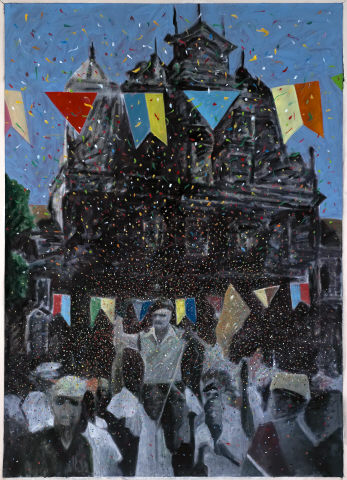
Bruno Pacheco
Help
Lisbon, Portugal, 1974
In 1999, he participated in his first group show in Oslo, followed from 2001 onwards by group shows in Lisbon, Porto, Madrid, Cáceres, London and Beijing. His first major solo exhibition was in 1998, at the Módulo gallery. In 2002, his video work was shown on two occasions through the Slow Motion project: at ESTGAD in Caldas da Rainha and the Calouste Gulbenkian Foundation in Lisbon.
His painting and drawing became more widely known following a solo exhibition at the Lisboa 20 gallery in 2004. In the same year, he exhibited at London’s Lawrence O’Hana Gallery and, soon afterwards, at the Haunch of Venison exhibition space, also in London, as well as CSC SIGMA, La Spezia, Genoa.
Basing his work on a continuous recollection of images, which he re-photographs before painting them, the artist selects details, gestures, objects and framings composing a jigsaw puzzle of images (in works where drawings compose panels) or isolated and fragmented proposals evoking symbolic and expressive narratives (in the case of his large paintings). Bruno Pacheco assumes an apparent discontinuity of the images in his work as a way of deconstructing meaning and legitimating discourse. His characters, drawn from those around him – family, friends, colleagues and pets, are often figures opposing a position of authority (a police officer, trainer, knight, sailor – individuals invested with the value of a distinctive uniform). Other figures are suggestive of fragility and sensitivity: maidens dressed in white, angels, acrobats illuminated by a spotlight on his frequently-used black background.
The flicker effect can indeed be extended to other definitions of atmosphere, detail, or the whole ensemble. It is as if light, worked in all its unreality, becomes the prime way of hinting at and suspending events, leaving them unexplained.
This is the same unreality which surrounds circus professionals, gymnasts and elephants, fireworks, equestrian scenes, with an emphasis on the atmosphere and relational tension, more than the characters. We often find ourselves somewhere between celebration and revolution, dignity and kitsch, a party and an illusion, buildings and vegetation, illuminated floors and the gloom of the surrounding sites, the uniqueness of an individual character and the erasure of their identity, the definition and the dilution of a shape.
The image is a flat plane in which painting is full of reminders of the illusion it creates. There is no texture or materiality in these paintings, despite the gestural value of many of the brushstrokes. There is something of the cinema screen in projections of variable sharpness, vaguely evocative of some of the issues raised by Luc Tuymans and Gerhard Richter.
The elements and processes of the painting are subjects juxtaposed with all the other themes and put on scales where the artist balances ideas and impressions, or even ideologies and aesthetic options.
Video is a medium with which the artist has worked, in parallel, since 1998, sometimes using it to question issues related to painting, such as effects of immateriality through the treatment of light. The artist also uses video to experiment with the most varied thematic registers: parodying the self-portrait, the theatrical ability to fake, the juxtaposition of the drawn image and the projected image and sound, evoking simultaneously a natural space and an interior space. Any possible intersections with the artist’s personal history are rendered imperceptible and irrelevant in the context of a proposal which is intended to be as autonomous as possible in its visual rhetoric.
In 2005, Pacheco won the União Latina award with an integrated video and painting as part of an exhibition presented at the Calouste Gulbenkian Foundation.
Also worthy of mention are the solo exhibition All Together, held at Culturgest in 2007 and, among other more recent shows, Uma História de Amor (A Love Story), at Chiado 8 – Contemporary Art, Lisbon and Mar e Campo (Sea and Countryside), at three different moments, at Casa das Histórias – Paula Rego, Cascais. He has participated in group exhibitions, such as To Have a Voice, at the GSA Mackintosh Museum, Glasgow, as well as exhibiting as an individual in 2006, 2008 and 2010 at the Hollybush Gardens Gallery, London – testimony to the close link he has maintained with the United Kingdom.
Leonor Nazaré
May 2013